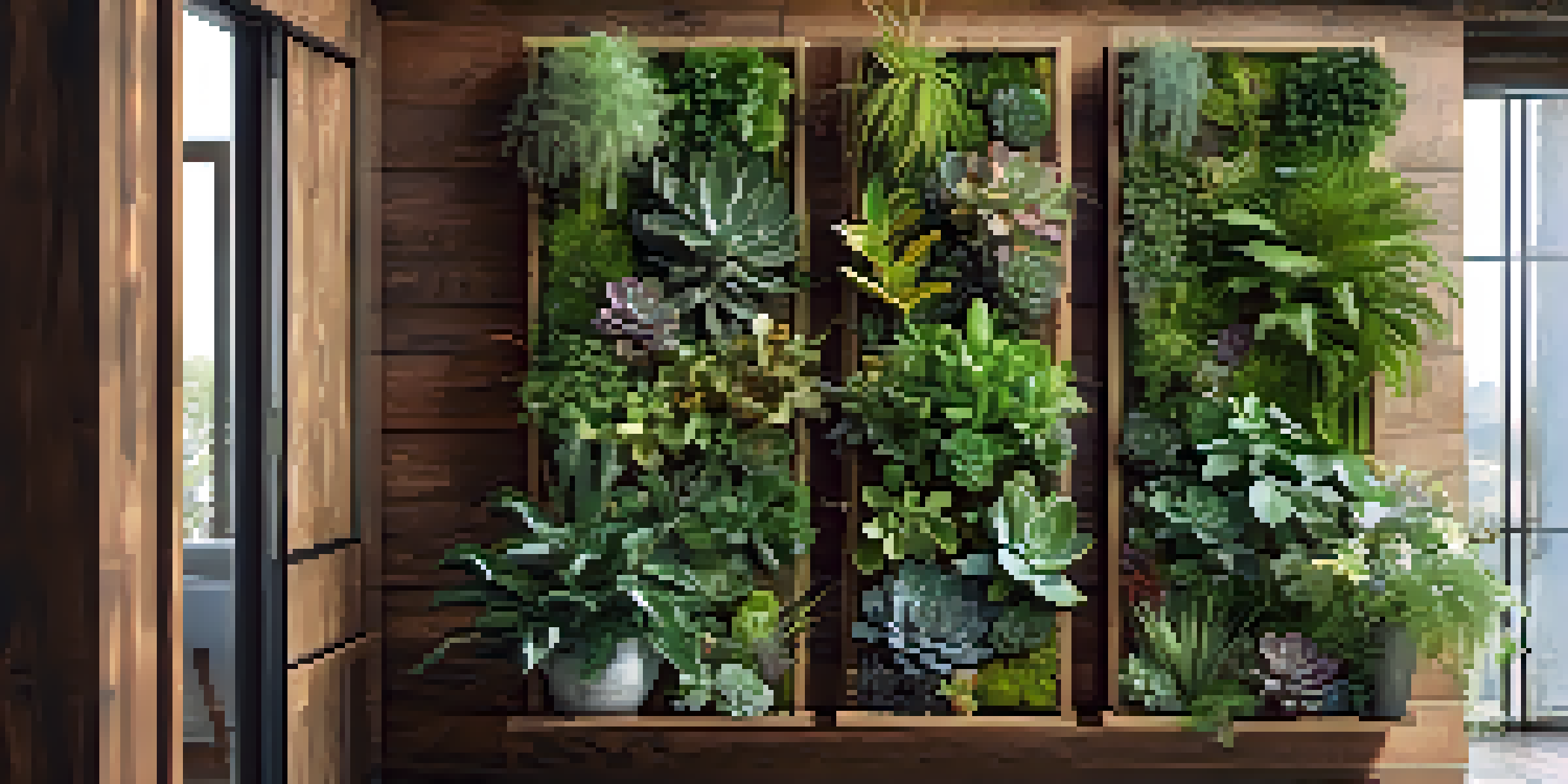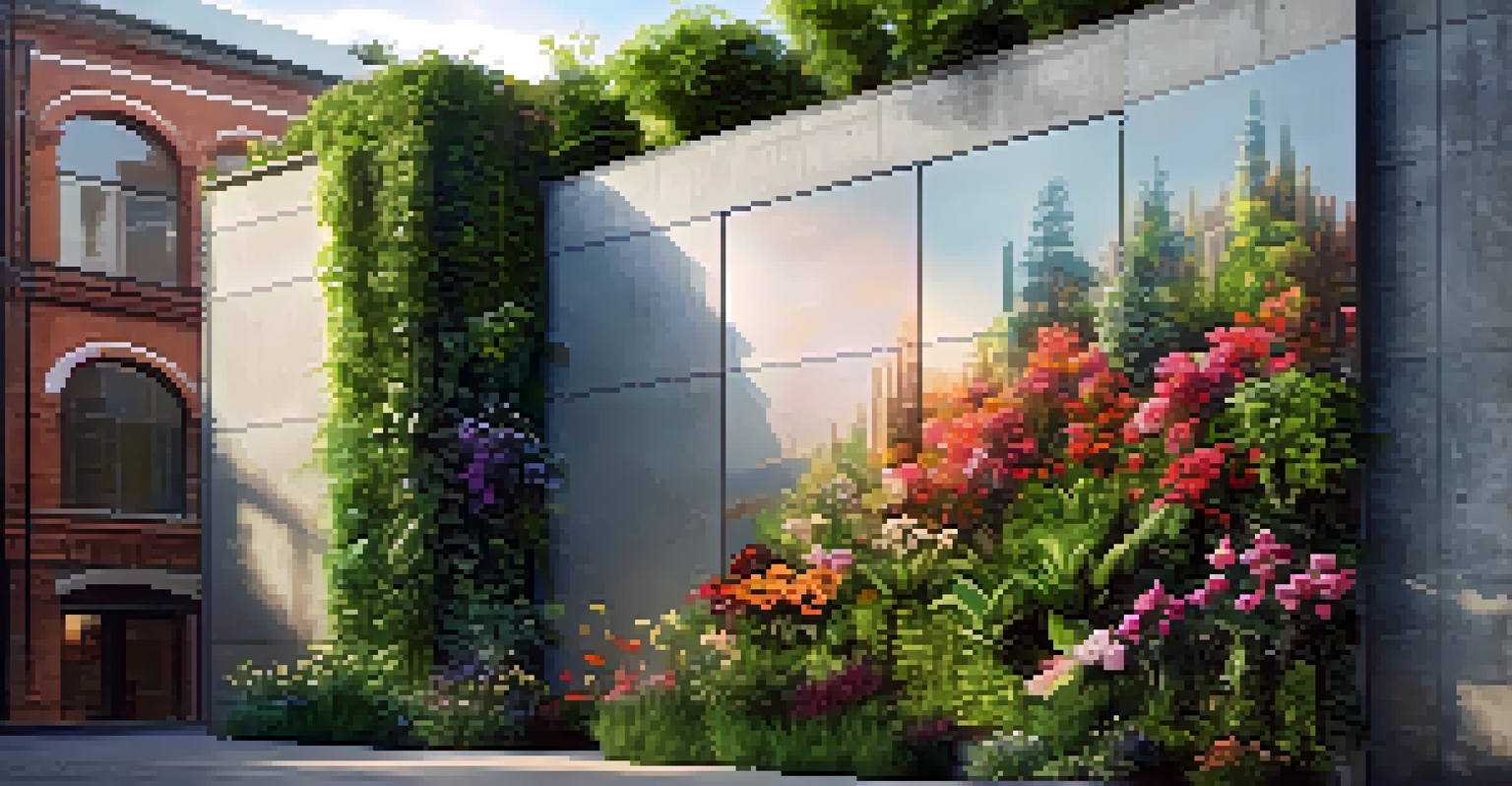The Aesthetic Benefits of Vertical Gardens in Design

Vertical Gardens: An Introduction to Living Art
Vertical gardens, also known as green walls, are a brilliant fusion of nature and design. These innovative structures allow plants to grow vertically, creating stunning visual displays that breathe life into any space. Imagine walking into a room and being greeted by a lush wall of greenery – it's not just eye-catching; it's a refreshing escape from urban surroundings.
The best time to plant a tree was twenty years ago. The second best time is now.
Incorporating a vertical garden into your design can transform a bland wall into a living masterpiece. They serve not only as decorative elements but also as conversation starters, inviting guests to engage with the space on a deeper level. This unique integration of nature can enhance the overall ambiance, making environments more inviting and relaxing.
Moreover, vertical gardens offer versatility; they can be tailored to fit various styles, from modern minimalism to rustic charm. By selecting specific plants and arranging them creatively, designers can express themes, moods, and even personal stories. It's like painting with living colors, where each plant contributes to the overall aesthetic.
Enhancing Urban Spaces with Vertical Gardens
In urban settings, vertical gardens are particularly beneficial as they maximize limited space. As cities become more crowded, the need for green areas grows, and vertical gardens provide an ideal solution. They allow us to bring nature into our homes and workplaces without requiring large footprints.

These green walls can also soften harsh architectural lines and create a balance between the built environment and nature. For instance, a vertical garden can transform a stark concrete wall into a vibrant tapestry of plants, making the space feel more alive and less industrial. This contrast is vital in creating a visually appealing urban landscape.
Vertical Gardens Enhance Spaces
Vertical gardens transform ordinary walls into living art, enhancing ambiance and inviting deeper engagement.
Additionally, the presence of greenery in urban areas can significantly improve residents' quality of life. Studies show that access to green spaces can reduce stress and enhance well-being, making vertical gardens not just beautiful, but also beneficial. They serve as a reminder of nature’s resilience amidst urbanization.
The Role of Color and Texture in Vertical Gardens
One of the most exciting aspects of vertical gardens is the variety of colors and textures they offer. Different plants can be combined to create breathtaking palettes, from vibrant flowering species to lush green foliage. This diversity adds depth and interest to a space, making it visually stimulating.
Nature does not hurry, yet everything is accomplished.
Textural variation is equally important; the combination of smooth leaves, fuzzy textures, and even spiky plants can create a fascinating visual experience. For example, pairing soft ferns with bold succulents can produce a striking contrast that draws the eye. This interplay of color and texture not only enhances aesthetics but also engages viewers on multiple levels.
Moreover, seasonal changes can offer dynamic visual interest as plants bloom and grow. This evolution keeps vertical gardens fresh and exciting, ensuring that they never feel static. It's like having a piece of art that constantly changes, bringing new life to the environment.
Creating a Calming Atmosphere with Vertical Gardens
Beyond their visual appeal, vertical gardens can create serene environments. The presence of greenery has a calming effect, helping to reduce anxiety and promote relaxation. Imagine sitting in a room surrounded by a living wall; the soothing colors and natural elements can transport you to a peaceful state of mind.
Incorporating vertical gardens into spaces like offices, waiting rooms, or even homes can significantly enhance the atmosphere. These gardens can serve as a natural sound barrier, absorbing noise and creating a quieter environment. This acoustic benefit, combined with the visual allure, makes for a truly restorative space.
Urban Benefits of Green Walls
In crowded cities, vertical gardens maximize space while improving air quality and the overall well-being of residents.
Furthermore, the act of caring for plants can also be therapeutic. Engaging with nature, even in small ways, can foster mindfulness and a sense of connection to the world. Vertical gardens encourage this interaction, allowing individuals to nurture their surroundings and, in turn, themselves.
Sustainability and Vertical Gardens in Design
Sustainability is a significant consideration in modern design, and vertical gardens align perfectly with this ethos. They contribute to biodiversity by providing habitats for various organisms, fostering a mini-ecosystem within urban settings. This not only enriches the environment but also supports local wildlife.
Moreover, vertical gardens can help improve air quality by filtering pollutants and releasing oxygen. This is especially crucial in cities, where air quality can often be compromised. By integrating green walls into urban design, we can combat pollution and create healthier spaces for everyone.
Using local plants in vertical gardens also promotes sustainability by reducing transportation emissions and supporting native ecosystems. This thoughtful approach not only beautifies spaces but also emphasizes the importance of caring for our environment. Vertical gardens become a testament to sustainable practices, reminding us of our responsibility to nature.
Practical Considerations for Vertical Garden Design
While vertical gardens offer numerous aesthetic benefits, practical considerations are essential for successful implementation. Factors such as sunlight, water availability, and plant selection should be carefully evaluated before installation. Understanding the specific needs of different plants ensures a thriving vertical garden that remains beautiful year-round.
Additionally, maintenance plays a crucial role in the longevity of vertical gardens. Regular care, including watering, trimming, and monitoring for pests, is necessary to keep the garden looking its best. Finding a maintenance routine that fits your lifestyle is key to enjoying the benefits of these green walls without feeling overwhelmed.
Sustainability Through Green Design
Vertical gardens support biodiversity and promote eco-friendly practices, making them essential in modern sustainable design.
Lastly, considering the structural aspects is vital. Vertical gardens need proper support and irrigation systems, which may require professional installation. By planning carefully and understanding these requirements, you can create a stunning and sustainable vertical garden that enhances your design for years to come.
The Future of Vertical Gardens in Design
As more designers embrace the benefits of vertical gardens, the future looks bright for this trend. With innovations in technology, we can expect to see even more efficient irrigation systems and plant selection tailored for various environments. This evolution will make vertical gardens more accessible and easier to maintain for everyone.
Moreover, as urbanization continues to rise, the demand for green spaces will only increase. Vertical gardens provide a compelling solution, allowing us to blend nature with our living and working environments. This adaptability ensures that vertical gardens will remain a staple in design for years to come.

Ultimately, vertical gardens symbolize a shift towards more sustainable and aesthetically pleasing design practices. They remind us of the importance of integrating nature into our everyday lives, creating spaces that are not only beautiful but also beneficial. As we look to the future, vertical gardens will undoubtedly play a significant role in shaping our urban landscapes.